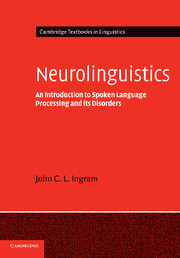Book contents
- Frontmatter
- Contents
- List of figures
- List of tables
- Preface and acknowledgements
- Note on the text
- Part I Foundational concepts and issues
- 1 Introduction and overview
- 2 Aspects of linguistic competence
- 3 The neuroanatomy of language
- 4 On modularity and method
- Part II Speech perception and auditory processing
- Part III Lexical semantics
- Part IV Sentence comprehension
- Part V Discourse: language comprehension in context
- Glossary
- References
- Index
1 - Introduction and overview
Published online by Cambridge University Press: 26 January 2010
- Frontmatter
- Contents
- List of figures
- List of tables
- Preface and acknowledgements
- Note on the text
- Part I Foundational concepts and issues
- 1 Introduction and overview
- 2 Aspects of linguistic competence
- 3 The neuroanatomy of language
- 4 On modularity and method
- Part II Speech perception and auditory processing
- Part III Lexical semantics
- Part IV Sentence comprehension
- Part V Discourse: language comprehension in context
- Glossary
- References
- Index
Summary
Introduction
This book is about language processing in the human brain and, more specifically, what happens to spoken language when certain areas of the brain are damaged. Language processing is what takes place whenever we understand or produce speech; a mundane task, but one of extraordinary complexity, whose mysteries have baffled some of the greatest minds across the centuries.
Neurolinguistics is the technical term for this field, introduced into academic usage by Harry Whitaker (1971), who founded the leading journal that bears this title. As Whitaker noted at the time, it is a key assumption of neurolinguistics that ‘a proper and adequate understanding of language depends upon correlating information from a variety of fields concerned with the structure and function of both language and brain, minimally neurology and linguistics’. Today, some thirty years later, it seems necessary to add ‘cognition’ or cognitive science to the list of minimally necessary disciplines. A well-articulated cognitive science is needed to provide the hoped for integration of two otherwise very different fields of study: language and neurobiology.
Considerable progress and a vast body of research have accumulated since then. Yet leading advocates of the cognitive science perspective on language as a biologically grounded human ability (such as Chomsky, Pinker and Deacon, to mention just three) disagree on some fundamental questions. To what extent are our language learning capabilities ‘hard-wired’ into the human brain and unique to the species? How is ‘innate linguistic competence’ actually deployed in language learning?
- Type
- Chapter
- Information
- NeurolinguisticsAn Introduction to Spoken Language Processing and its Disorders, pp. 3 - 14Publisher: Cambridge University PressPrint publication year: 2007



